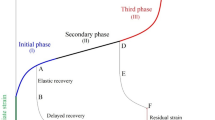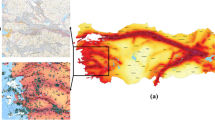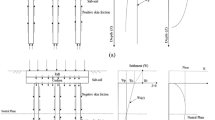Abstract
Concrete arch dams require foundation and abutment with high resistance since they have a particular structure and bear almost high loads induced by hydrostatic pressure. On the other hand, rock masses with high strength are fractured over time under tectonic effects and thermal stresses and usually, they include different degrees of joints. Previous investigations showed that, in most cases, these joints greatly affect the rock masses safety. For this reason, in the present study, the role of joints in the initial evaluation of rock mass as foundation and abutment was investigated for a cracked concrete arch dam. The effect of various geometrical parameters of joints, including their orientation and mechanical characteristics, on the safety of the foundation and abutment of cracked concrete arch dam was examined using finite element method (FEM). Different stages of dam construction were implemented in 3D modeling in order to apply real loads. To investigate the constructed models, the Morrow Point dam was selected as base dam and it was verified. The results showed that the geometric pattern of joints (slope and slope direction) and their mechanical characteristics significantly influence the safety of concrete dam supports. By controlling these parameters, the positioning conditions of dams can be evaluated. The effects of these parameters on the crack conditions are discussed in detail for a better understanding of further studies.






















Similar content being viewed by others
References
ABAQUS FEA (2009) ABAQUS analysis user’s manual. Dassault Syst Vélizy-Villacoublay, Fr
Andjelkovic V, Pavlovic N, Lazarevic Z, Nedovic V (2015) Modelling of shear characteristics at the concrete–rock mass interface. Int J Rock Mech Min Sci 76:222–236
Douglas K (2002) The shear strength of rock masses [PhD thesis]. Sch Civ Environ Eng Univ New South Wales
Federal Energy Regulatory Commission (FERC) (2002) Federal Energy Regulatory Commission (FERC)Engineering guidelines for the evaluation of hydropower projects Federal Energy Regulatory Commission, Washington, D.C.
FERC (2016) (Federal Energy Regulatory Commission) Engineering guidelines for the evaluation of hydropower projects. Chapter III: gravity dams, Washington, DC, USA
Hennig T, Wang W, Feng Y et al (2013) Review of Yunnan’s hydropower development. Comparing small and large hydropower projects regarding their environmental implications and socio-economic consequences. Renew Sust Energ Rev 27:585–595
ICOLD (2004) (International Commission on Large Dams) Sliding safety of existing gravity dams—final report, Paris, France
Koopialipoor M, Tootoonchi H, Marto A et al (2018) Various effective factors on peak uplift resistance of pipelines in sand: a comparative study. Int J Geotech Eng:1–8
Krounis A, Johansson F, Larsson S (2016) Shear strength of partially bonded concrete–rock interfaces for application in dam stability analyses. Rock Mech Rock Eng 49:2711–2722
Kupfer HB, Gerstle KH (1973) Behavior of concrete under biaxial stresses. J Eng Mech Div 99:853–866
Momenzadeh M, Koopialipoor M, Mansoori M (2018) Determination of the racking reduction factor in a horseshoe shaped tunnel section considering the soil-structure interaction. Geotechnical and Geological Engineering 36(6):3903–3910
Momenzadeh M, Koopialipoor M, Tootoonchi H, Khalili F, Khorami S, Khorami S (2019) Investigation of Seismic Reliability Index in Shallow Underground Tunnels by Combining Three Methods of Surface Response, Hasofer-Lind and Finite Element Method. Geotechnical and Geological Engineering 37(5):3903–3914
Moradian ZA, Ballivy G, Rivard P et al (2010) Evaluating damage during shear tests of rock joints using acoustic emissions. Int J Rock Mech Min Sci 47:590–598
Mouzannar H, Bost M, Leroux M, Virely D (2017) Experimental study of the shear strength of bonded concrete–rock interfaces: surface morphology and scale effect. Rock Mech Rock Eng 50:2601–2625
Nuss LK, Matsumoto N, Hansen KD (2012) Shaken, but not stirred—earthquake performance of concrete dams. In: Proceedings of the 32nd Annual USSD Conference
Qi S, Wu F, Yan F, Lan H (2004) Mechanism of deep cracks in the left bank slope of Jinping first stage hydropower station. Eng Geol 73:129–144
Ren Q, Li Q, Liu S (2012) Research advance in failure risk and local strength failure for high arch dams. Chin Sci Bull 57:4672–4682
Song Z, Liu Y, Yang Q (2016) Experimental and numerical investigation on the stability of a high arch dam with typical problems of nonsymmetry: Baihetan Dam, China. Bull Eng Geol Environ 75:1555–1570
Tian HM, Chen WZ, Yang DS, Yang JP (2015) Experimental and numerical analysis of the shear behaviour of cemented concrete–rock joints. Rock Mech Rock Eng 48:213–222
Tinawi R, Léger P, Leclerc M, Cipolla G (2000) Seismic safety of gravity dams: from shake table experiments to numerical analyses. J Struct Eng 126:518–529
US Army Corps of Engineers (1994) Engineering and design: arch dam design. Books Express Publishing, United Kingdom
USACE US (1995) Army Corps of Engineers. Gravity Dam Design–Engineering and design (engineer manual). EM 1110–2-2200
Wittke W, Leonards GA (1987) Modified hypothesis for failure of Malpasset dam. Eng Geol 24:367–394
Wyllie DC (1999) Foundations on rock: engineering practice, 2nd edn. E & FN Spon, London
Zhang L, Liu YR, Yang Q (2015) Evaluation of reinforcement and analysis of stability of a high-arch dam based on geomechanical model testing. Rock Mech Rock Eng 48:803–818
Author information
Authors and Affiliations
Corresponding author
Ethics declarations
Conflict of interest
The authors declare that they have no conflict of interest.
Rights and permissions
About this article
Cite this article
Armaghani, D.J., Bayat, V., Koopialipoor, M. et al. Investigating the effect of jointed environment on the cracked concrete arch dam in 3D conditions using FEM. Bull Eng Geol Environ 80, 55–70 (2021). https://doi.org/10.1007/s10064-020-01935-3
Received:
Accepted:
Published:
Issue Date:
DOI: https://doi.org/10.1007/s10064-020-01935-3




